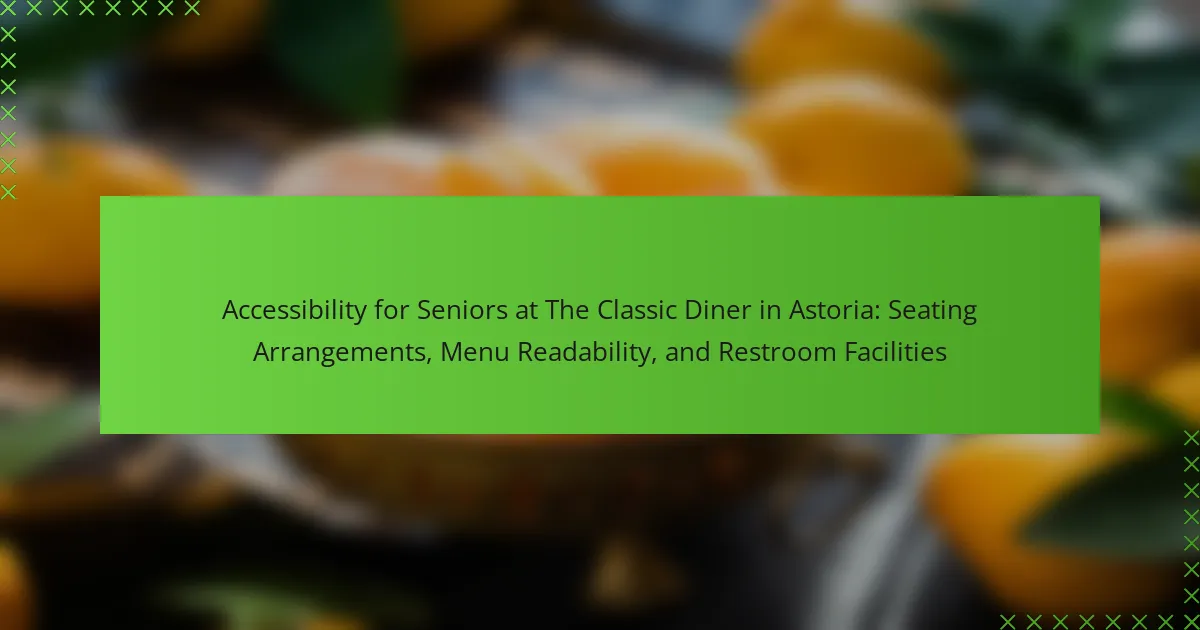
What is Accessibility for Seniors at The Classic Diner in Astoria?
Accessibility for seniors at The Classic Diner in Astoria includes features designed to enhance comfort and ease of use. The diner offers wheelchair-accessible seating arrangements. Tables are spaced to allow for easy navigation. Menu readability is improved with large print options. The restroom facilities are equipped with grab bars and are wheelchair accessible. These features ensure a welcoming environment for seniors.
Why is accessibility important for seniors at dining establishments?
Accessibility is important for seniors at dining establishments to ensure their comfort and safety. Many seniors have mobility issues that make navigating spaces challenging. Accessible entrances and seating arrangements can prevent falls and injuries. Additionally, clear menu readability caters to those with vision impairments. Proper restroom facilities are essential for maintaining hygiene and dignity. According to the U.S. Census Bureau, approximately 15% of seniors have difficulty walking or climbing stairs. Providing accessibility can enhance their dining experience and encourage social engagement.
What specific challenges do seniors face in traditional dining environments?
Seniors face several specific challenges in traditional dining environments. Limited mobility can make it difficult for them to navigate through crowded spaces. Many seniors require assistance with seating and may struggle with low or high chairs. Menu readability is often an issue due to small print and complex descriptions. Noise levels in traditional dining settings can hinder communication and cause discomfort. Additionally, restrooms may not be easily accessible, lacking grab bars or appropriate signage. These factors can significantly affect their dining experience and overall enjoyment.
How can accessibility enhance the dining experience for seniors?
Accessibility enhances the dining experience for seniors by providing ease of movement and comfort. Accessible seating arrangements accommodate mobility aids like walkers and wheelchairs. Wider aisles allow seniors to navigate the space without obstacles. Menu readability, with larger fonts and clear layouts, helps seniors make informed choices. Well-designed restroom facilities ensure safety and convenience, reducing the risk of accidents. According to the American Association of Retired Persons (AARP), accessible dining options significantly improve satisfaction among older adults. Enhancing accessibility meets the needs of seniors and promotes inclusivity in dining experiences.
What are the key aspects of accessibility at The Classic Diner?
The key aspects of accessibility at The Classic Diner include wheelchair access, seating arrangements, menu readability, and restroom facilities. The diner features ramps and wide doorways to accommodate wheelchairs. Tables are arranged to allow easy navigation for patrons with mobility aids. The menu uses large print and clear fonts for better readability. Restrooms are equipped with grab bars and are spacious enough for wheelchair users. These features ensure a comfortable dining experience for seniors and individuals with disabilities.
How are seating arrangements designed to accommodate seniors?
Seating arrangements are designed to accommodate seniors by ensuring comfort and accessibility. Chairs are typically chosen for their ergonomic design, providing proper support. The height of the seating is adjusted for easy entry and exit. Tables are spaced to allow for mobility aids, such as walkers or wheelchairs. Lighting is enhanced to improve visibility and safety. Non-slip flooring is often used to prevent falls. Additionally, staff training includes assisting seniors effectively. These features collectively create a welcoming environment for older adults.
What features enhance menu readability for seniors?
Larger font sizes enhance menu readability for seniors. Text sizes of at least 14-16 points are recommended. High contrast between text and background improves visibility. For instance, black text on a white background is ideal. Simple language and clear descriptions help comprehension. Avoiding jargon and complex terms supports understanding. Use bullet points or lists to organize items clearly. This structure allows for easier scanning of options. Additionally, including images or icons can aid in recognition of menu items.
How do restroom facilities cater to the needs of senior patrons?
Restroom facilities cater to the needs of senior patrons by incorporating design features that enhance accessibility and safety. These facilities often include grab bars near toilets to assist with stability. They may also provide non-slip flooring to prevent falls. Senior-friendly restrooms typically have wider stalls to accommodate mobility aids like walkers or wheelchairs. Additionally, toilets are often installed at a height that is easier for seniors to use. Clear signage with large print helps seniors locate restrooms easily. Adequate lighting ensures safety and visibility. These features collectively improve the restroom experience for senior patrons, promoting independence and comfort.

How do seating arrangements support senior accessibility at The Classic Diner?
Seating arrangements at The Classic Diner enhance senior accessibility by providing ample space for mobility aids. The diner features wider aisles to accommodate wheelchairs and walkers. Tables are arranged to allow easy access without obstruction. Many seating options include chairs with armrests for easier standing and sitting. The diner prioritizes ground-level seating to eliminate stairs. Additionally, designated areas are reserved for seniors to ensure convenience. These arrangements promote a comfortable dining experience for elderly patrons.
What types of seating options are available for seniors?
Seniors have several seating options available to them. These include standard dining chairs, which provide basic support. There are also high-backed chairs that offer additional neck and back support. Booth seating is another option, providing comfort and ease of access. Some diners offer adjustable seating to accommodate different needs. Wheelchair-accessible tables are crucial for seniors with mobility challenges. Additionally, cushioned seats can enhance comfort during longer meals. Finally, some establishments provide specialized seating with armrests for easier standing and sitting. These options ensure that seniors can dine comfortably and safely.
How does the layout of the diner facilitate easy movement for seniors?
The layout of the diner facilitates easy movement for seniors through wide aisles and strategically placed seating. Wide aisles allow seniors to navigate without obstacles. This design minimizes the risk of tripping or bumping into furniture. Additionally, the seating is arranged to avoid crowding. This arrangement provides ample space for seniors to maneuver their mobility aids. Clear pathways lead to restrooms and exits, enhancing accessibility. The diner also includes handrails in critical areas for added support. Overall, these features create a safe and comfortable environment for seniors.
What adjustments are made to seating height and comfort for seniors?
Adjustments for seating height and comfort for seniors include using chairs with a higher seat height. This makes it easier for seniors to sit down and stand up. The recommended seat height is typically between 18 to 20 inches from the ground. Additionally, chairs often have armrests to assist with stability. Cushioned seats provide extra comfort and support. Backrests are designed to promote proper posture. Some establishments also offer adjustable seating options. These adjustments help reduce strain and enhance overall comfort for seniors.
How is menu readability ensured for seniors at The Classic Diner?
Menu readability for seniors at The Classic Diner is ensured through several specific design choices. The diner uses large, clear fonts on the menu to enhance visibility. High-contrast colors are employed to make text stand out against the background. Additionally, the menu layout is simple and uncluttered, facilitating easier navigation. Descriptions of menu items are concise, avoiding overwhelming information. Staff members are trained to assist seniors with menu selections when needed. These strategies collectively improve the overall dining experience for older patrons.
What font size and style are used to enhance visibility?
Font size and style that enhance visibility typically include larger sizes and sans-serif fonts. A font size of at least 14 to 16 points is recommended for better readability. Sans-serif fonts like Arial or Helvetica are preferred because they have clean lines. These styles reduce visual clutter and improve legibility. Studies show that sans-serif fonts are easier to read for older adults. High contrast between text and background also aids visibility. Using bold text can further enhance clarity.
Are there any additional aids for seniors to understand the menu?
Yes, there are additional aids for seniors to understand the menu. Large print menus are often available to enhance readability. Some establishments provide audio menus for those with visual impairments. Staff members are trained to assist seniors in navigating the menu. Visual aids, such as pictures of food items, can also be beneficial. These aids improve comprehension and enhance the dining experience for seniors.

What restroom facilities are provided for seniors at The Classic Diner?
The Classic Diner provides accessible restroom facilities for seniors. These restrooms feature grab bars to assist with stability. They are designed with wider stalls to accommodate mobility aids. The facilities are equipped with non-slip flooring for safety. Additionally, the restrooms have adequate lighting for visibility. These features ensure a comfortable experience for seniors. The diner prioritizes accessibility in its restroom design.
How are restroom facilities designed with seniors in mind?
Restroom facilities are designed with seniors in mind by incorporating features that enhance safety and accessibility. Grab bars are installed near toilets and in shower areas to provide support. Non-slip flooring reduces the risk of falls, which is crucial for elderly users. Wider stalls accommodate mobility devices like walkers and wheelchairs. Lever handles on doors are easier for seniors to operate than traditional knobs. Adequate lighting improves visibility, helping seniors navigate the space safely. Higher toilets are available to assist those with limited mobility. These design elements collectively create a safer and more user-friendly restroom experience for seniors.
What specific features make restrooms accessible for seniors?
Accessible restrooms for seniors include features like grab bars, non-slip flooring, and wider stalls. Grab bars provide support for seniors when using toilets. Non-slip flooring reduces the risk of falls. Wider stalls accommodate mobility devices like walkers and wheelchairs. Lever-style faucets are easier to operate than traditional knobs. Raised toilets assist with sitting and standing. Adequate lighting improves visibility for seniors with vision impairments. Clear signage helps seniors locate restrooms easily. These features enhance safety and comfort for senior users.
How does the diner ensure cleanliness and safety in restroom facilities?
The diner ensures cleanliness and safety in restroom facilities by implementing regular cleaning schedules. Staff members conduct cleaning multiple times throughout the day. They use disinfectants that meet health standards for sanitizing surfaces. Restrooms are stocked with essential supplies like soap and paper towels. Signage is posted to remind patrons to wash their hands. Safety measures include non-slip mats to prevent falls. The diner also conducts periodic inspections to maintain hygiene standards. These practices contribute to a safe environment for all customers.
What best practices can enhance accessibility for seniors in dining settings?
Best practices to enhance accessibility for seniors in dining settings include providing adequate seating options. Tables should be at a comfortable height for seniors. Chairs should have armrests to assist with sitting and standing. Clear pathways should be maintained for easy navigation. Menu readability is crucial; use large fonts and high-contrast colors. Staff should be trained to assist seniors with menu choices. Restroom facilities must be accessible, featuring grab bars and non-slip flooring. Lighting should be bright to aid visibility. These practices improve the dining experience for seniors and promote inclusivity.
How can diners implement effective communication strategies with senior patrons?
Diners can implement effective communication strategies with senior patrons by using clear and respectful language. Speaking slowly and articulately helps ensure understanding. Maintaining eye contact fosters a connection and shows attentiveness. Additionally, using simple vocabulary avoids confusion. Listening actively allows diners to respond to specific needs or concerns. Providing written materials in large print enhances readability. Offering assistance without being intrusive demonstrates respect for independence. These strategies improve the dining experience for seniors, as studies show that clear communication positively impacts customer satisfaction.
What training should staff receive to assist seniors effectively?
Staff should receive training in communication techniques tailored for seniors. This includes speaking clearly and slowly. Staff should also learn to use non-verbal cues effectively. Understanding common age-related health issues is essential. Training should cover mobility assistance, including how to help seniors navigate the diner safely. Staff should be educated on the importance of patience and empathy. Knowledge of menu items and dietary restrictions is crucial for effective service. Training programs should incorporate role-playing scenarios to practice these skills.
The main entity of the article is “Accessibility for Seniors at The Classic Diner in Astoria.” The article provides a comprehensive overview of the various accessibility features available to seniors, including wheelchair-accessible seating, large print menus, and well-designed restroom facilities. It highlights the importance of accessibility in enhancing the dining experience for seniors, addressing common challenges they face in traditional dining environments. Key aspects such as seating arrangements, menu readability, and restroom accessibility are discussed in detail, emphasizing how these elements contribute to a comfortable and inclusive atmosphere for older patrons.
